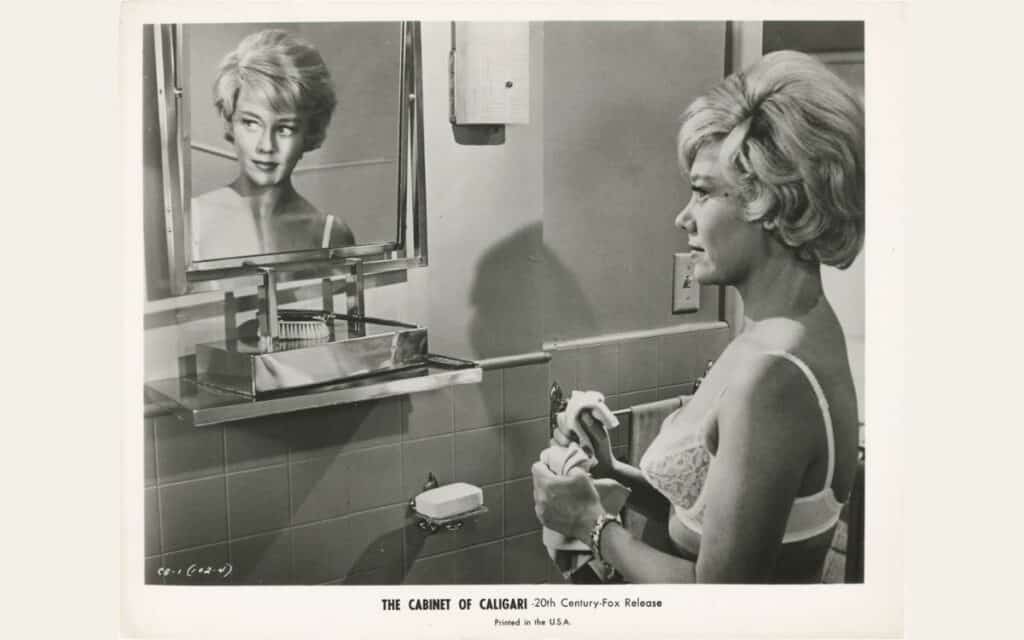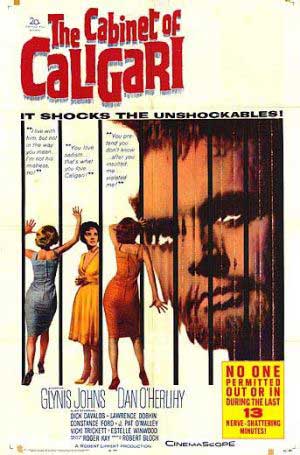The Cabinet of Caligari 1962 is anything but like the original silent-era masterpiece, STEVIE MILLER reviews

TITLE: The Cabinet of Caligari
RELEASED: 25 May 1962
DIRECTOR: Roger Kay
SCREENPLAY: Robert Bloch
CAST: Glynis Johns, Dan O’Herlihy, Dick Davalos, Lawrence Dobkin, Constance Ford, Estelle Winwood, J. Pat O’Malley
The Cabinet of Caligari 1962 Review
The Cabinet of Caligari is a 1962 black and white horror film written by Robert Bloch, author of the novel Psycho. With such an esteemed writer, one would have been expecting a classic horror, but alas, this was not to be the case.
The film starts with Jane, played by Glynis Johns, driving her car, which ends up getting a puncture. She is now stuck out in the middle of nowhere and walks to find help.
Luckily (or unluckily), she comes across a sprawling mansion, where she is greeted at the door by the mysterious Caligari, played by Dan O’Herlihy, who invites her into the building.
On first impression, he is a polite and helpful man. As Jane is very tired, he offers her shelter and arranges for someone to see to her car.
It’s here that we begin to get a glimpse of Jane’s unravelling mental situation in the form of a dialogue between her and Caligari.
Jane: “I need help.”
Caligari: “I can see you need help.”
Jane: “I had a breakdown.”
It seems that not just her car is in trouble.

The following day, she meets the various other house guests. She is drawn to three: a man called Paul, an elderly lady named Ruth, and a handsome young man called Mark.
Jane goes to see Caligari, where he questions her about herself. He passes her a set of cards that the audience don’t see. They disgust her. She then throws them at Caligari and flees his office.
Soon after, Jane meets up with Mark, who it is clear she has a liking for. He then says he can’t see her again until after dinner the following day – but she is confused about why they can’t meet sooner. He gives her a music box which takes her back to her childhood.
Later, in Caligari’s office, Jane is again questioned, this time more intensely and perversely. Caligari then locks her in the office, where she proceeds to cry for her mother and wants to go home.
Caligari somewhat chillingly explains to Jane: “If you want to leave here, you must come back.”
She then meets Paul, who is very kind and gentle; there is a stark contrast between him and Caligari. Paul agrees to help her escape.
Later in her room, Jane wakes up to screaming coming from the building. Running down the corridor, she sees fellow “guest” Ruth in a chair being beaten to death, with Caligari looking on.
In distress, she runs back to her room. While there, Paul comes to see her, but Jane is frightened that she might suffer the same fate as Ruth because she bore witness to the incident. Paul tells her, “Don’t worry, he didn’t see you”.
Paul tells Jane to confront Caligari, so she heads to his office. But, once there, she is astonished and upset to find out that Paul and Caligari are the same person.
She collapses and, upon waking, she is told she is finally allowed to leave.
We now see that Jane, it turns out, is not 27, as she mentioned when she first met Caligari, but a much older lady.
Jane sees Ruth, who it turns out is a patient, just like her. The “torture” she saw Ruth be subjected to was, in fact, electroconvulsive therapy, a procedure she has once a week.
Mark then pulls up in her car; in a Freudian twist, it turns out that he is her son. It now becomes clear that he could not meet her until after dinner because of visiting time restrictions at the hospital.
The cards Jane was shown in Caligari’s office were Rorschach Blotts – ink shapes on a card that are said to allow the mind to create an explanation for an undefined ink pattern.
And, the intense questioning she was receiving from Caligari was part of psychoanalytic therapy.
So, all the time, Jane was in a mental institution, suffering the debilitating effects of a breakdown, and the clues were there all along.
Summing up a Hard Watch
I’m not going to lie; I found this a tough watch. I expected a film based on the original 1920s version, The Cabinet of Dr Caligari, which is superb.
This, however, is not.
I don’t know what audience the film was trying to appeal to as, personally, I would not call it a horror, but more of a psychological “thriller”.
The director didn’t like it much more, either.
In 1963, Roger Kay disowned the film. He was annoyed at Fox for turning the film, in his words, into “a lurid, sex-charged picture” and claimed the version released was considerably different from his original vision.
Kay’s original copy of his cut is with the Museum Of Modern Art.
Did You Know?
Films such as Psycho were routinely billed with the warning that once the film began, late patrons would not be seated. However, in a punishing twist, those watching The Cabinet of Caligari 1962 were not allowed to leave during the last 13 minutes of the film. I would have paid good money to have escaped the cinema long before Jane did Caligari.
Tell us your thoughts on The Cabinet of Caligari 1962 in the comments section below!




I liked it – but I think it would have benefited from not being saddled with a title which heaped so much expectation and anticipation on the part of the audience.
what was Jane’s breakdown about? it isn’t explained in the film at the end?